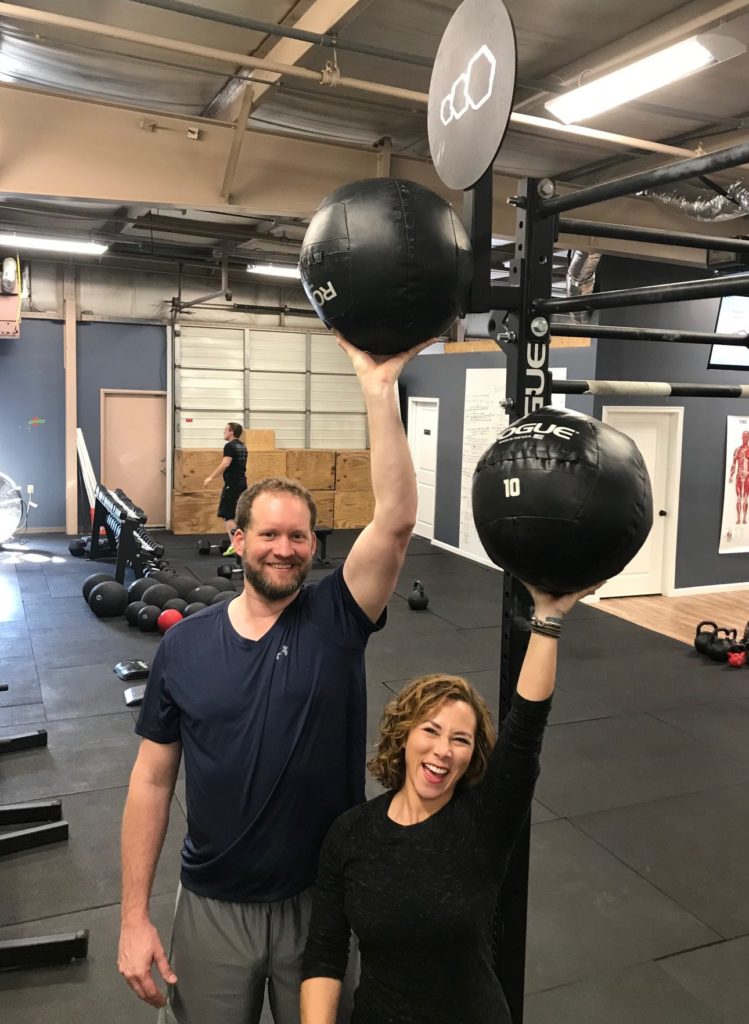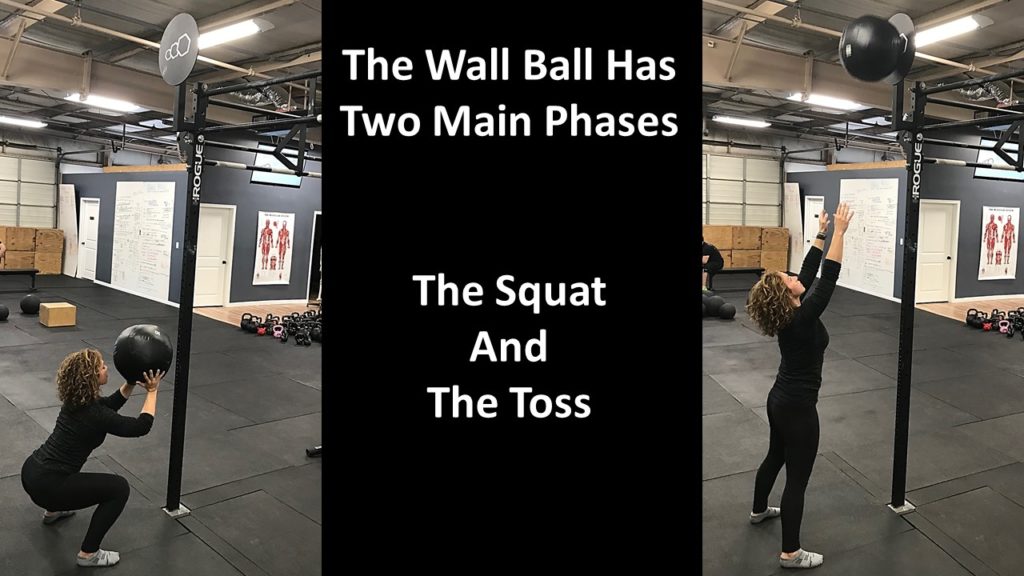Are wall balls harder for short people? If you do any of today’s popular high-intensity exercise programs you are used to doing a wide range of workouts and movements. And you’ve probably noticed that some of these exercises favor shorter people. Chief among those would be pull-ups, burpees, cleans, and muscle-ups which are all easier for smaller people. (You can check out the math on pull-ups at this link.) But there are some exercises where we megafauna have a pretty clear advantage over the smaller athletes we compete against. Tall people have better proportions for exercises like rowing, air bike, and box jumps.

Dr. James Larson is an orthopedic surgeon specializing in sports medicine and arthroscopic surgery. He also holds a CF-L1 certificate and is a Certified BFR Specialist. He supports weight training and high-intensity exercise throughout the lifespan. He started LSO to keep more people moving better, longer.
But one movement has always puzzled me: Wall balls. On one hand, it’s obvious that short people have to throw the ball a lot further to hit the target. But that line of reasoning doesn’t account for how much more work is required for a big person to squat. Surely a tall persons total mass would make the squat portion of a wall ball much harder for tall people. Short people may have to throw that 20-pound ball an extra two feet. But there’s no way that can be harder than having to squat my extra 100 pounds of body weight over my entire height, right? So which factors win in the end?
Well, I’ll tell you this: One of these groups needs to use a much heavier ball to even things out. Want to know who it is and how much heavier their ball is? Keep reading to find out!
Special thanks go out to my friend Peter Boettcher, PhD. Was it overkill to check my calculations with a professor of mathematics at MIT? Probably, hahaha! But I feel better knowing I’m bringing you the most accurate info.

What is a Wall Ball?
A wall ball is an exercise popular among today’s trainers and fitness athletes. It’s a full-body workout where you have to squat and then stand to chuck a 10-20 pound ball at a target ten feet in the air and then catch it. Rinse and Repeat until you feel like puking. Here’s a quick video demonstration: Wall Ball Form and Technique. And a link to inexpensive wall balls on Amazon in case you need one for home use. Or maybe you just want to be “That Guy” and bring your own wall ball to competitions. I’m not judging.
What Parts of Wall Balls Benefit Tall People?
Several aspects of this movement benefit tall people. First, they have a more efficient transfer of momentum because of their weight. Secondly, they also have their full height over which to accelerate so they can use a lower force. And the obvious one, the distance to throw the ball is smaller, meaning it takes less force to do so.
Transfer of Momentum
If we are talking about two fit people, the tall person is generally going to weigh more. And the goal of this exercise is to transfer enough momentum to the ball so it can reach the target. A more massive person can transfer momentum to the ball much easier since the momentum of an object is just mass times speed.
Momentum = Mass x Velocity
Just imagine getting tackled by two people. The first one is my size and weighs 250lbs. The other is a short person that weighs 110lbs. If we are moving at the same speed, I’m obviously going to knock you a lot farther. That’s “transfer of momentum.” And throwing a wall ball works on the same principle. All of my mass transfers energy to the ball much more efficiently than a smaller, lighter person. Of course, momentum doesn’t give us the true velocity needed to hit the target. For that, we need to calculate energy. Which we will get to soon!
Longer Distance to Accelerate
The second factor that benefits tall people during wall balls is the distance our bodies move. When you need to reach a certain velocity, it’s more efficient to apply a smaller force over a longer distance. Since taller people have a longer distance to apply a force to the ball, our legs don’t have to work as hard to get the same result.
The best analogy for this is trying to merge onto the highway. When you have a short on-ramp, you need to redline the engine to get moving at highway speed. But a longer on-ramp means you can be easier on the gas pedal to reach the needed speeds. In the same way, the short person has a shorter on-ramp. They really have to push hard to get the speed needed to get the ball to the target. The tall person has a long on-ramp and doesn’t have to push as hard to get the ball moving fast enough.
Now, couple that with the fact that a tall person doesn’t need the ball moving as fast to hit the target and you get a major difference in effort. Overall it’s more like short people are trying to merge onto the Autobahn while tall people are just hanging a right turn onto a country lane!

Closer To The Target
And finally, the most obvious factor. Tall people have to throw the ball a shorter distance. I’m 6’8″ with long arms. I can touch 8 feet while standing! Compare that to someone with a height of 5 feet who can reach just over 6 feet. I only have to toss that ball 2 feet, while the short person has to throw it 4 feet. The tall person has the obvious advantage.
This is where we are going to get into some actual numbers. To put this in physics term, the kinetic energy we impart to the ball at release has to equal the potential energy as the ball hits its maximum height when striking the target.
Potential Energy = (Mass of ball) x (Height of throw) x (Gravity)
In this scenario, we’ll use the height as the distance between the point of release and apex of the throw, since that is the distance the ball has to travel. For these calculations, we will change the numbers to metric values: An 20 pound ball is roughly 9 kg; 2 and 4 foot throws translate to 0.6 meters and 1.2 meters respectively. And gravity is a constant acceleration of 9.8.
PE Tall = 9kg x 0.6m x 9.8m/s2 = 53 J
PE Short = 9kg x 1.2m x 9.8m/s2 = 106 J
So it takes double the energy for short people during the throw! No surprise there. If you have to throw the same object twice as far, it takes twice the energy. But remember how we talked about short people needing a faster velocity to give the ball the energy needed to travel the extra distance? We can calculate that also.
Calculating Velocity
The kinetic energy of the ball at the release has to equal the potential energy at the apex of the throw.
Kinetic Energy = ½ ( Mass of ball ) x (Velocity)2
AND
Kinetic Energy at Release = Potential Energy at Target
SO
½ ( Mass of ball ) x (Velocity)2 = (Mass of ball) x (Height of throw) x (Gravity)
Let’s put those into real numbers. For the short person we have ½ ( 9kg ) x (Velocity)2 = (9kg) x (1.2m) x (9.8). And after the algebra, the velocity a short person needs is 4.84 m/s. And for the tall person ½ ( 9kg ) x (Velocity)2 = (9kg) x (0.6m) x (9.8). So solving for the velocity there, we get a required velocity of 3.43 m/s for the tall person. So essentially, short people need to be moving 40% faster when they release the ball!
But that’s not the end of the story. There is one factor that overturns this whole line of reasoning: The Squat. And squats are exponentially harder for taller people. But is that enough to overcome the difference in the throw? Will it make the wall ball harder for tall people after all?

What Factors Benefit Short People?
There really is only one way that short people win during a wall ball. That’s the squat. When it comes to squatting, the tall people lose out drastically. As we get bigger, our weight increases faster than our height. And this puts taller people at a disadvantage when it comes to all bodyweight exercises. Let’s see how big a difference it actually makes. To calculate the energy expended to do a squat we will use some of the numbers we calculated before and come up with total work done.
Work (Energy) = mass x gravity x distance moved
For these numbers, we are going to keep it simple and just calculate the amount of work you would do during a regular squat. We are using their body weight for mass and the average length of the femur as the distance squatted assuming you squat to parallel.
Solving that equation for the tall and short people, we find the following numbers:
- Work of squatting for a tall person: 540J.
- Work of squatting for a short person: 176J.
Add the work of throwing the ball and we get the following numbers:
- Total work of squat and toss for tall person: 590J
- Total work of squat and toss for short: 280J
Maybe Wallballs Are Harder for Tall People Afterall?
Uh oh. That’s pretty definitive, right? Tall people expend more than twice the energy of a small person when doing a wallball. So why do wall balls feel so much harder for short people? It doesn’t make intuitive sense, right? Well here’s the secret to why wall balls are actually harder for shorter people.
It’s All About Ratios
When you look at the ratios of energy expended, you can see the real reason that wall balls are harder for short people. A wall ball requires a short person to increase their total energy output by more than 60% when compared to a squat. That’s a huge difference! In contrast, a tall person only has to increase energy output by about 10% when comparing a squat to a wall ball. So it’s not truly about the total energy expended. Rather its the increased energy output from the baseline exercise of squatting that makes wall balls so much more difficult for shorter people.
A tall person would need to hit a target at 21 feet to make wallballs as difficult for them!
Want to translate that into terms we can understand? If we actually wanted to make the increased energy expenditure for tall people to a level commensurate with short people, we would have to give them a wall ball that weighed nearly 120 lbs! Alternatively, you could raise the target height for the tall person also. How high? How does a 21 foot high target sound? This is really where all those early points come into play. Having to accelerate faster, give the ball more speed, and losing out on the benefits of momentum are what lead the proportions to be so out of whack for shorter people.
A few caveats
Please, please, please, please! DO NOT try a 120lb wall ball folks, you’ll break your neck! Also as a caveat, these numbers aren’t exact, there are a few places that where I left out some smaller calculations that depend too much on variable aspects of the squat acceleration. And I’m just talking ratios, so left out a few aspects of the movement for simplicity’s sake in calculations. And if you’ve followed me this far, I assume you can do the math for figuring out that 120 lb wall ball and 21-foot target height. It’s just a ratio to figure out the energy and then solving for weight or distance in the potential energy calculation, but I figured I’d included enough formulas for most readers by this point.

